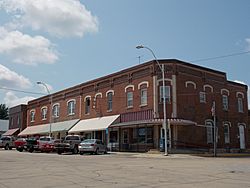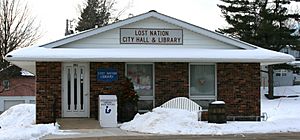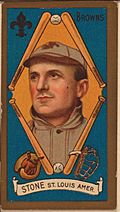Lost Nation, Iowa facts for kids
Quick facts for kids
Lost Nation, Iowa
|
|
|---|---|
 |
|

Location of Lost Nation, Iowa
|
|
| Country | |
| State | |
| County | Clinton |
| Incorporated | July 9, 1903 |
| Area | |
| • Total | 0.76 sq mi (1.96 km2) |
| • Land | 0.76 sq mi (1.96 km2) |
| • Water | 0.00 sq mi (0.00 km2) |
| Elevation | 755 ft (230 m) |
| Population
(2020)
|
|
| • Total | 434 |
| • Density | 574.07/sq mi (221.55/km2) |
| Time zone | UTC-6 (Central (CST)) |
| • Summer (DST) | UTC-5 (CDT) |
| ZIP code |
52254
|
| Area code(s) | 563 |
| FIPS code | 19-46605 |
| GNIS feature ID | 0458634 |
Lost Nation is a small city in Clinton County, Iowa, in the United States. In 2020, about 434 people lived there.
Contents
History of Lost Nation
The area that is now Lost Nation has been known by that name since at least 1855. No one is quite sure how it got its unique name!
The town was officially planned out in 1872. It became an official city in July 1903. A train station was built there in 1871, which helped the town grow. By 1911, Lost Nation was one of the first small towns in eastern Iowa to have electricity.
Geography of Lost Nation
Lost Nation is a small city. It covers about 0.76 square miles (1.96 square kilometers) of land. There is no water area within the city limits.
People of Lost Nation
| Historical populations | ||
|---|---|---|
| Year | Pop. | ±% |
| 1910 | 523 | — |
| 1920 | 537 | +2.7% |
| 1930 | 493 | −8.2% |
| 1940 | 493 | +0.0% |
| 1950 | 557 | +13.0% |
| 1960 | 567 | +1.8% |
| 1970 | 547 | −3.5% |
| 1980 | 524 | −4.2% |
| 1990 | 467 | −10.9% |
| 2000 | 497 | +6.4% |
| 2010 | 446 | −10.3% |
| 2020 | 434 | −2.7% |
| Source: and Iowa Data Center Source: |
||
In 2020, there were 434 people living in Lost Nation. Most of the people living in the city were White (about 93%). A small number of people were from other racial backgrounds. About 1.2% of the population was Hispanic or Latino.
The average age of people in Lost Nation was about 44 years old. About 25% of the residents were under 20 years old. Many people were also 65 years or older, making up about 24% of the population. There were slightly more females than males living in the city.
Fun Things to Do
Annual Events
Rustic Days
Lost Nation has a special event each year called Rustic Days. It happens during the third weekend of July. This fun event includes a "Rustic Run" race, a parade, and a street dance where everyone can enjoy music and dancing.
Schools
Students in Lost Nation attend schools within the Midland Community School District. The local Lost Nation school district joined with the Midland district on July 1, 1993.
Famous People from Lost Nation
Lost Nation has been home to a few famous people:
- Jim McAndrew (1944–2024) was a professional baseball pitcher. He played in Major League Baseball and was a World Series Champion with the New York Mets.
- Ken Ploen (1935-2024) was a famous Canadian Football League quarterback. He is in the Hall of Fame for his time with the Winnipeg Blue Bombers.
- Joe Seng (1946-2016) was a politician who served in the Iowa state government.
- George Stone (1876–1945) was a professional baseball player. He was a left fielder in Major League Baseball and won a batting championship.
See also
 In Spanish: Lost Nation (Iowa) para niños
In Spanish: Lost Nation (Iowa) para niños



